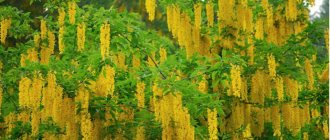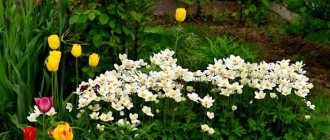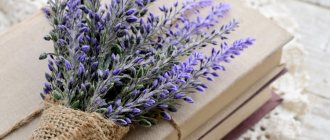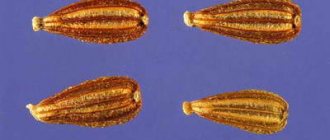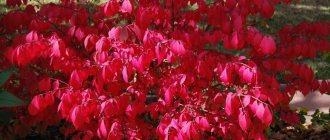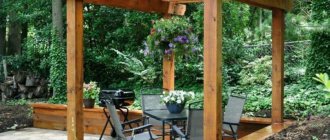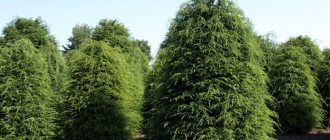A plant such as Brunnera or Brunnera is directly related to the genus of herbaceous perennial plants of the borage family. This genus includes 3 species. These plants are found naturally in Western and Eastern Siberia, the Caucasus and Asia Minor. This flower was named after the Swiss S. Brunner, who is known as a traveler and botanist. Only 2 types of brunnera are cultivated, namely: Siberian and large-leaved. These plants are most often used to create borders and for stable decorative groups as part of mixborders.
Options for using brunera in landscape design: photo options
The beauty of brunera lies in its wide green or silver leaves and small blue, white or dark blue flowers. The plant wakes up early in the spring: flowering begins in April and continues for 3-4 weeks. It can be combined with the same early flowering plantings: tulips, daffodils, muscari, hyacinths.
Brunnera is an indispensable plant for a shady or semi-shady area. It combines well with shade-loving hosts and astilbe. The plant is planted in mixborders, alpine slides, gardens in Japanese and Chinese styles. When planting in a mixborder, it is placed in the foreground, and it will highlight tall flowers.
How you can use the brunera flower in landscape design:
general information
Brunnera is a perennial that is especially common in Siberia and the Caucasus. In gardening, it is planted to decorate borders, landscape compositions and all kinds of mixborders.
The average height of the herbaceous bush is 50 cm. Large, whole leaves on long petioles resemble a heart. The shoots are slightly pubescent, making them appear softer.
Brunner flowers are very small, no more than 1 cm in diameter, and most often even smaller. They really resemble forget-me-nots, and for this feature Brunnera is popularly called forget-me-not. But you can notice a slight difference: the spot in the middle of the brunnera is white, not yellow.
Photo: greenpoint24.ru
Popular varieties and types of Brunnera
In garden conditions, 2 types of brunnera are cultivated: large-leaved (Brunnera macrophylla) and Siberian (Brunnera sibirica). The first one looks the most impressive. The plant is winter-hardy, can withstand temperatures down to -30°C, so it can be planted in various regions, including the Moscow region.
Below are popular varieties of brunners with photos and names:
- Silver Hut (Silver Heart). This variety has beautiful silvery leaves. The veins and border have a rich green color. Silver Hut is undemanding to soil composition and can grow in direct sunlight.
- Variegata. The leaf blades of Brunnera Variegata have a white edge, the flowers are painted with a blue palette. The more sun that hits them, the larger and brighter the white area.
- Looking Glass. The leaves have a predominant silver tint. The veins are olive-silver, the flowers are blue.
- King's Ransom. The large heart-shaped leaves are light gray in color. Dark emerald veins are clearly visible on them. The bush is low-growing, barely reaching 20 centimeters.
- Jack Frost. The main background of the leaves of Brunnera Jack Frost is silvery, as if covered with frost. A thin green border is visible along the edges. Bushes require spraying once every 2 weeks.
Brunnera sibirica has heart-shaped, wrinkled basal leaves, growing on the stems - lanceolate. They are not painted as variegatedly and effectively as those of large-leaved
The positive qualities of crop cultivation include the following characteristics:
- decorativeness;
- shade tolerance;
- winter hardiness;
- ease of care;
- ease of reproduction.
Disadvantages include frequent damage to bushes under unfavorable conditions by powdery mildew and brown spot.
Description
Brunners are characterized by a thick rhizome, large broad-heart-shaped leaf blades, and pubescent branched stems. Small corollas are collected in loose paniculate or corymbose inflorescences.
- The pistil and stamens do not protrude.
- The fruits of the forget-me-not are small dry nuts. They appear by the end of August.
- The height of the perennial is from 45 to 55 cm. Its distribution area is Asia Minor and Siberia.
- The blooming corollas of Brunnera decorate the garden throughout the month. The flowering period occurs in April-May. Among the distinctive features is a white spot inside the flower.
- An adult plant forms low thickets that do not require complex care.
Additional advantages of brunners include their winter hardiness and visual attractiveness.
Landing
Brunnera can be grown from seeds at home and then planted in open ground.
Seeds
Seed material is purchased at a flower shop. In winter they are kept in the refrigerator, where they undergo stratification. In the spring, the seeds are sown in a box, and when a pair of true leaves appear on them, they are planted in separate containers. After hardening, bushes grown in containers are planted in open ground at the end of summer or early autumn.
Seedlings grown at home are planted in pre-dug small holes.
Planting plants in the ground
If a gardener wants to sow seeds directly into the ground, then he should do this in the fall. Over the winter they will naturally undergo a process of aging in cold conditions (stratification).
7.Forcing brunners at home
If desired, you can get a flowering bush by the desired date and this process is called forcing. Plants are dug up in the autumn months and sent to small boxes with moist and nutritious soil; you can also plant the flower directly in the pot.
Before the onset of night frosts, it is better to leave such boxes and pots in the fresh air. After the temperature at night begins to take negative values, the boxes are brought into the house, placing them in a dark and cool place - for example, in the cellar.
A month to a month and a half before the expected flowering period, the boxes are taken out of the cellar, placed on the windowsill and begin to be watered. Soon after changing the conditions of maintenance, the first young leaves will be noticeable.
↑ Up,
Features of care
Brunnera is a moisture-loving plant, so it requires frequent and abundant watering. After planting, the trunk circle of bushes should be mulched with peat, compost or sawdust. This will retain moisture in the soil, and the mulch will also prevent the growth of weeds. The root system is close to the soil surface, so weeding is not recommended.
Spring care
In spring, bushes can be fed with nitrogen to actively increase green mass. When the buds begin to fade, the flower shoots are removed to maintain the decorative appearance of the plant.
Summer care
In the middle of summer, the leaves of Brunnera Siberia begin to dry out, so the entire above-ground part of the plant is removed during this period. In summer, the bushes can be fed with mineral fertilizers. By early autumn, young foliage appears.
in autumn
Some varieties of forget-me-nots may begin to bloom again in the fall. It is better to remove them, since flowering takes away a lot of the plant’s strength, which is necessary for successful wintering.
8.Useful properties
Brunner also paid attention to traditional medicine. The plant is used as an anti-inflammatory agent; it is also believed that the flower has an antipyretic effect and a laxative effect.
The harvesting of green mass is carried out during the flowering period - it is at this time that the maximum amount of useful substances accumulates in plants. The leaves are cut with a sharp knife and sent to dry in a warm place with good air movement. During the drying process, the raw materials should not be exposed to direct sunlight - ultraviolet radiation can destroy many compounds in the leaves.
Leaf blades are hung upside down, collected in small bunches or laid out in a thin layer on racks. The finished raw materials are lightly crushed and stored in fabric or paper bags for 1 - 2 years, using as needed.
↑ Up,
Reproduction
You can grow forget-me-not brunnera by seeds, dividing bushes, or pieces of rhizomes. Typically, the plant is propagated in the local area using the last two methods. Overgrown bushes are dug up, divided into parts, and planted in holes. Each plant divided into parts must have a rhizome and a flower bud.
For propagation by rhizomes, the root of the flower is dug up and divided into 5-6 cm sections. Rhizomes with buds are planted to a depth of 3 centimeters, watered and mulched. Flowering will occur next season.
Story
Little is known about the ancient history of Brunei. In the VI century. trade was carried out with China and tribute was paid. Presumably, the local rulers were vassals of the Indonesian state of Srivijaya. One of the states that existed on the territory of modern Brunei is Pony, mentioned in Chinese and Arabic sources. In the 10th century Trade relations were established with the Chinese Song and Ming empires. The first Sultan of Brunei was Muhammad Shah, who before the adoption of Islam bore the name Alak-ber-Tata (reign 1363-1402). The state reached its peak in the first half of the 16th century. During the reign of the fifth Sultan Bolkiyah (1485-1521), Brunei controlled almost the entire territory of Kalimantan, the Sulu Islands and others at the northwestern tip of Kalimantan. The first Europeans to visit Brunei in 1521 were sailors from the expedition of Ferdando Magellan. In the 16th century. Brunei was a powerful feudal state that occupied a significant part of the island of Borneo and some neighboring islands.
Francis Grant “Portrait of James Brooke” In 1839, the English adventurer James Brooke, who was in the service of the Sultan, suppressed the Dayak uprising that threatened the position of the Sultan, and received from him “as a gift” for the service of land in the north of the country (Sarawak) and the title of “raja”. The White Rajah (Brooke) dynasty ruled there until World War II, during which Sarawak was occupied by Japan. After the end of the war, Sarawak became subordinate to the British crown, and in 1962 became part of Malaysia. In 1888, the whole of Brunei became a British protectorate. In 1950, the new Sultan Omar Ali Saifuddin III ascended the throne; he had quite liberal views, tried through diplomatic means to obtain concessions from the British to their country. He used the increased contributions to the Sultanate's budget after the war, which came from the government, for a number of progressive reforms. In particular, state old-age pensions, free schooling and medical care were introduced. In 1952, the first newspaper in the Malay language began to be published in Brunei, and in 1956, the country's first higher education institution, a teacher training college, was opened. Brunei's economy began to strengthen. In 1959, after a series of uprisings, Great Britain granted Brunei autonomy in matters of internal self-government. Brunei was planned to join Malaysia in 1962, but an uprising led by the Brunei People's Party (BPP) disrupted these plans. The uprising was brutally suppressed by British troops. The armed uprising of 1962 is a bright and heroic page in the history of Brunei. It demonstrated the desire of the small people of this country to achieve, at any cost, the opportunity to develop freely and independently build their future. The Sultan, whom the British suspected of sympathizing with the NPB, subsequently abdicated the throne in favor of his son. On January 1, 1984, the full independence of Brunei was proclaimed. In 1992, the concept of the “Malayan Islamic Monarchy” was adopted.
Sultan Hassanal Bolkiah pursues a policy of careful modernization of society
Sultan of Brunei Hassanal Bolkiah
Forward >
Diseases and pests
The crop may suffer from powdery mildew and brown spot. Diseases most often occur when the summer is too wet or, conversely, dry. To prevent diseases, bushes are sprayed with fungicides.
If misfortunes have already appeared, then the above-ground part is first completely removed, and only then the soil is irrigated against the pathogenic microorganisms remaining in it. Among the pests, bushes can be favored by aphids and whiteflies. They get rid of them by spraying with Karbofos or Actellik.
Brunnera is an unpretentious plant, and there are usually no problems (except for the diseases and pests mentioned above). The bushes grow strongly, so they need to be planted in rock gardens with caution. You can restrain growth by inserting limiters around the perimeter.
Siberian brunella
Culture
Incarvillea care - Photo of incarvillea
The country lives according to Sharia law. Literature in the Malay language and traditional arts - shadow theater (wayang), orchestra of gongs and metallophones (gamelan) are successfully developing. Traditional dwellings are located on stilts; the Dayaks have a so-called “long house” (up to 200 m). Everyday clothing for men and women is the sarong, which is a long skirt made of a piece of fabric. The sarong is an indispensable accessory of costume during worship. Men often wear it over their trousers. More details about the sarong.
Sarong (or sarung) is a traditional men's and women's clothing of a number of peoples of Southeast Asia and Oceania. It is a strip of colored cotton fabric that wraps around the waist (or the middle of the chest for women) and covers the lower part of the body to the ankles, like a long skirt. Common in Bangladesh, Cambodia, Malaysia, Myanmar, India, Indonesia, Polynesia. Different peoples have their own ways of tying a sarong, but in all cases its use serves the same purpose: protecting the skin from the sun and providing the body with ventilation from below in a hot tropical climate. For for convenience when working or to keep warm in case of cold weather, the sarong's flaps can be tied in a knot or tucked into the belt. Cuisine: as in the entire region, the basis of food is fish and rice. Since most of the population is Muslim, pork is avoided. Alcohol is prohibited in Brunei. In rural areas, wild birds, Indian sambar and muntjac are hunted. Dishes in Brunei are usually spicy, rich in spices, usually served with rice or noodles as a side dish. Among Brunei's signature dishes is the sweet ambuyat, a sticky ball of starch that is dipped in a sweet fruit sauce.
Common drinks include coconut milk, fruit juice, tea and coffee. Tourists can learn about the country's cultural history at the National Museum of Brunei, where Muslim art, natural history, traditional culture of Brunei, Brunei Darussalam: Archeology and History are on permanent display.
Tourism
Sultan Omar Ali Saifuddin Mosque and Ceremonial BoatTourism in Brunei has been developing since the mid-1990s. Key places to visit include the capital Bandar Seri Begawan, where the Sultan's Palace is located; museums; Omar Ali Mosque; a centuries-old collection of 28 villages on the water - Kampung Ayer, as well as the Jerudong Park Nature Park in Tutong. Ecotourism is represented by the tropical jungle in the Temburong National Park.
Nature
As we have already said, Brunei is located on the northwestern coast of the island of Borneo and consists of two separate regions. The island of Borneo (aka Kalimantan) is the third largest island in the world; the only sea island divided between three countries: Indonesia, Malaysia and Brunei. The island is located in the center of the Malay Archipelago.
In addition to rich oil deposits, the island has rich diamond reserves. There are no large lakes or rivers in the country. The rivers (Brunei, Tudong, Temburog, Belait) flow from the hills of the southern part of the country to the north, emptying into the South China Sea.
Brunei River The climate is humid and equatorial. Subject to strong influence of monsoons from the South China Sea. There are earthquakes. More than 75% of the territory is covered with tropical rainforests. Mangroves (evergreen deciduous forests) are also common in the tidal zone on the coast of Brunei. Due to the powerful dense forest, most of the country’s territory cannot be inhabited.
Tropical forestThe forests are home to more than 200 species of rare and endangered birds, 150 reptiles and amphibians, and one hundred mammals. The Peradeian Forest Reserve is the most accessible forest in Brunei and is home to many interesting local species: squirrels, tree shrews, primates and the endemic mouse deer, a tiny member of the cervid species, not much larger than rodents. Kancil (mouse deer) is the most the oldest ungulate animal on Earth among all modern ones. And the smallest thing.
His height is only 20-25 cm. Weight is 1.5 kg. The thickest representatives of the species reach 2.5 kg. Deer mice are soft and fluffy, covered in grayish fur, often with an orange tint. But these deer have fangs! However, they almost never use them. These are very shy animals that lead a secretive lifestyle. They are active mainly at night, and during the day they sleep in rock crevices or hollow logs. And at night they wander in search of food. They feed on plant foods - leaves, flowers, fruits. Kanchil sometimes seeks salvation in the water. They are excellent swimmers and can walk along the bottom without sticking out for a long time.
Links
Bruniaceae (lat. Bruniaceae) is a family of flowering plants from South Africa, consisting of 11-12 genera and approximately 60-70 species. Plants of this family are shrubs and herbs of various appearances.
In the APG II (2003) classification system, the Bruniaceae family is included in group Euasteridae II, but is not included in any orders.
Several species of plants, mostly from the genus Brunia, grown for cutting, are of practical importance.
Brunia:
Brunia (animal) (lat. Brunia) is a genus of butterflies of the Ursa family (Arctiidae);
Brunia (plant) (lat. Brunia) is a genus of angiosperms of the Bruniaceae family.
Chivalry is a fraternity, a privileged military-landowning class in Western Europe in the Middle Ages. Knighting was regarded as a royal reward for public service. In the Middle Ages in Europe, brotherhoods of knights were divided into religious and secular. The first class includes knights who took a religious vow, for example, members of the Order of the Templars and the Knights of St. John (Hospitaliers), knightly orders that fought against the Saracens (Arabs) and other non-Christians. The second class arose from knights who were in the royal service or served the high nobility. Chivalry originates from medieval France and Spain, subsequently spreading throughout Europe, reaching its greatest flourishing in the 12th-13th centuries. Intensified during the Crusaders
Chivalry can also be seen as a code of conduct and honor that medieval knights were required to adhere to. In fact, this code was rarely observed, but, thanks to courtly literature, a romantic image of a gallant knight was formed in the mass consciousness, and the word “knight” itself over time became synonymous with a person of noble morals.
Modern government structure
The form of government is absolute monarchy. The head of state and government is the Sultan. He is also the religious leader of the country's Muslims. The government consists mainly of his close relatives. The capital is Bandar Seri Begawan. The largest city is Bandar Seri Begawan. The official language is Malay. English and Chinese are widely spoken. The urban population is 75%. Brunei is unevenly populated: 1/3 of the population lives in the capital, the other significant part is concentrated in the oil fields. The state religion is Sunni Islam - 67% of the population, 13% are Buddhists, 10% are Christians (mainly Protestants and Catholics), 10 % – others (mainly aboriginal cults). Confucianism and Taoism are widespread in Chinese communities. Territory - 5,765 km².
Population – 401,890 people. Ethnic composition: Malays (66%), related ethnic groups - Kelayans, Ibans, Melanaus, Dusuns, Muruts, Dayaks, etc. - 8%. The country is inhabited by the Chinese (11%), Europeans, Indians and others. The currency is the Brunei dollar.
Transport aircraftArmed Forces - The Royal Brunei Armed Forces consist of the ground forces, air force, and navy. There is a "Gurkha reserve unit" of British Army veterans. Performs the functions of the Sultan's personal security and protection of oil facilities. Subordinate to the Brunei Ministry of Internal Affairs.
Education - the education system in Brunei is structured differently for the children of the British colonialists and for the indigenous population (Malays, Chinese, etc.). White children at the age of 6 enter a 6-year primary school, then move on to an 8-year secondary school. To enter a higher education institution outside Brunei, you must study for another 2 years after graduating from high school. Local children are accepted into primary 6-year schools at the age of 6 years. The duration of study in secondary school is 6 years (3 years at the first stage and 3 years at the second). In Chinese schools, instruction is conducted in Chinese, in other schools - in Malay; English is also taught in all schools. Vocational education is poorly developed: there is a trade and technical school and a pedagogical school operating on the basis of a secondary school. Administrative division - 4 districts (daera). The districts are divided into districts (mukim).Economy. Brunei is one of the richest and most prosperous countries in the world. Thanks to its rich oil and gas reserves, Brunei ranks among the first in Asia in terms of living standards. The basis of the state's economy is the extraction and processing of oil (over 10 million tons per year) and gas (over 12 billion m³), the export of which provides more than 90% of foreign exchange earnings. Brunei ranks 4th in the world in the production of liquefied gas. The country has a developed pulp and paper industry, the production of mineral fertilizers, building materials, and timber logging and processing. Rice, corn, coconut and sago palms, bananas, yams, spices, sweet potatoes, cassava, cocoa beans, and coffee are grown here. But agriculture is poorly developed. Livestock: buffaloes, goats, chickens. Handicrafts: gold and silver embroidery, making jewelry and bronze souvenir guns. Export: crude oil, petroleum products, natural gas, clothing. Import: food (80%), industrial products, consumer goods.
Sports - various sports are developed: football, tennis, badminton, golf, table tennis, squash (playing ball with special rackets), field hockey, swimming, athletics, snooker, windsurfing, bowling. National sports are cultivated: Malay volleyball (sepak takraw), the local form of martial arts silat, spinning top (gasing), tug of war (tariq qalat). National board games: chongkak and main pasang.
Gardeners' opinion
Brunnera grows behind all my flowers, since I don’t take care of its plantings. I have had it in one place for more than 15 years and I have never specifically watered or fed it. The only thing I do is periodically plant young bushes for my neighbors.
Elena, Ufa
For me, the varietal Brunnera does not cause much trouble. I rarely water. But everything that has been sown by self-sowing has to be weeded, since it grows without varietal characteristics.
Svetlana, Moscow
Brunnera macrophylla is an irreplaceable perennial that can decorate any garden and requires only minimal care.
State symbols
The flag is a 3-color panel with an aspect ratio of 1:2. Yellow color is traditional. The mast, bird wings, umbrella and pennant are symbols of power. The hands represent concern for the welfare of the people. Arabic inscription on the crescent: “Eternal service to Allah.” At the bottom of the ribbon is the inscription: “Brunei is the abode of peace,” this is the motto of the small sultanate, which is included in the official name of the country: Brunei Darussalam. The flag was approved on September 29, 1959.
The coat of arms is the emblem of Brunei. Consists of five main elements: a flag, a royal umbrella, a wing, arms and a crescent. On the crescent moon, in Arabic, the national motto is: "Always in service under the guidance of God." On the ribbon is the name of the nation in Arabic: “Brunei Darussalam”, or “Brunei - land of peace.” The wings symbolize the defense of justice and peace. The crescent is a symbol of Islam, the national religion of Brunei. The hands symbolize the government's responsibility to protect the people. The emblem was approved in 1921.
Sights of Brunei
Bandar Seri Begawan
The capital and largest city of Brunei with a population of more than 140,000 people. The city is home to the country's main mosques, historical sites, museums, an Arts and Crafts Center, and cultural and recreational parks. Let's talk about some of the capital's attractions.
Royal Ceremonial Hall, or Lapau
It is used for royal traditional ceremonies. It was here that Sultan Hassanal Bolkiah was crowned on August 1, 1968. The interior of Lapau and the throne of the Sultan are decorated in gold. Official permission is required to visit this building.
Malayan Technical Museum
The museum was officially opened by His Majesty the Sultan on February 29, 1988. The museum has 3 exhibition halls, which display various types of crafts and handicrafts, exhibits demonstrating methods of cultivating the land, methods of producing sago, brown sugar, etc.
Istana Nurul Iman
In the courtyard of the palace, the residence of the Sultan of Brunei. The palace is located several miles outside the city center. Istana Nurul Iman is considered to be the largest residential palace in the world.
Kampong Ayer
It is a cluster of 42 villages with more than 30,000 inhabitants, the world's largest water village. It is called the “Venice of the East”. It is located not far from the capital. The houses are built on stilts, and wooden paths are stretched between the houses. The small villages are connected by pedestrian bridges over 29,140 m long. There are 4,200 structures: houses, mosques, restaurants, shops, schools and hospitals.
High SchoolPrivate water taxis provide fast travel. Most of these taxis resemble long wooden speedboats. From a distance, the water village looks like a slum. But in fact, it is fully equipped with modern amenities, including air conditioning, satellite TV, Internet access, plumbing and electricity. Some residents raise potted plants and chickens.
The second largest city in the country, after Bandar Seri Begawan. Tourists here are attracted by a park and beach along the South China Sea, a boat club, a market, a sushi restaurant, the most famous Japanese restaurant in the country, the historical village of Kuala Balai, etc.
